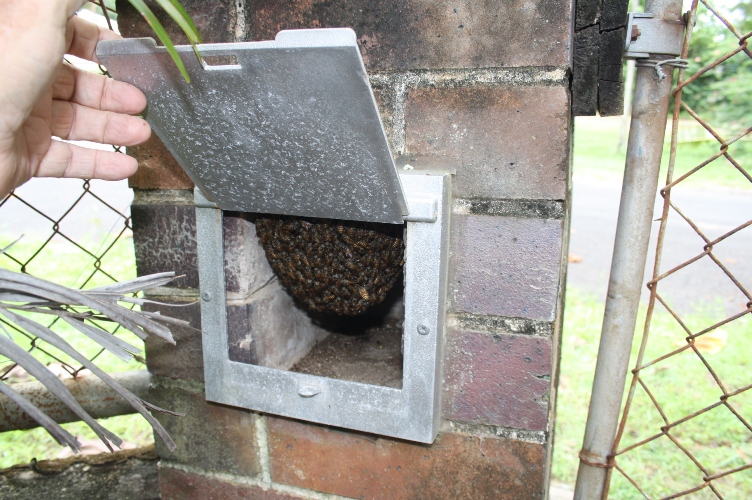So far I have mainly discussed the
social insects in the suborder Apocrita (wasps, ants and bees) from which most
of Hymenoptera belong to. But there is another suborder of the Hymenoptera –
the Symphyta - which contains the sawflies, horntails and parasitic wood wasps.
| Image 1: Paperbark or Melaleuca Sawfly (Lophyrotoma zonalis) |
The Symphyta are believed to be the most primitive of the order based on their
morphology and being that they are the first hymenopterans found in fossils – the earliest being Xyelidae found in Middle Triassic
fossil records from Central Asia (Wang et al, 2014). The Xyelidae are
considered to be the basal group from which all other hymenopterans evolved and some of the members of this superfamily have primitive features that have been abandoned
by other hymenoptera (Gauld & Bolton, 1988).
 |
Image 2: Dorsal view of Sawfly (Cathayxyela extensa sp.) fossil found in China (Wang et al, 2014).
|
One of the distinctions between
Symphyta and Apocrita is the ovipositor – on Symphyta it is saw-like (hence the
name sawflies) which allows the female to make slits or borings in the host
plant in which to lay her eggs (Gauld & Bolton, 1988). Morphologically the
Symphyta also lack the tapered typical wasp-waist and a stinger as seen on the Apocrita and hold
their wings flat over the body (The University of Edinburgh, 2001). Although not
social, there is evidence of group pupation and some mother Symphyta will
provide defence to young and will viciously attack predators (Costa, 2007).
| Image 3: Sawfly (Perga sp.) mother defends her offspring, photo courtesy of Kristi Ellingsen. |
The larvae of Symphyta feed on host
plants completely exposed, in leaf rolls/webs or concealed within parts of the
plant such as the fruit; however there are some species (from the Orussidae
superfamily) that are parasitic (Gauld & Bolton, 1988). Adult sawflies feed
from flowers, on parts of the flower and some species are carnivorous (Gauld
& Bolton, 1988). The majority of Symphyta larva
are caterpillar-like but have at least six pairs of prolegs compared to the
caterpillars maximum of five and lack the hooks that caterpillars have on their
prolegs (Barnard, 2011).
Having a similar life to the caterpillar, Symphyta larvae
are subject to similar selective pressures as butterfly larva and they have
developed similar chemical and communicative defence mechanisms (Costa, 2007).
Communication has been observed in Australian species Perga affinis and Perga
dorsalis in the form of substrate borne vibrational cues made by a hardened
cover on the tip of the abdomen being tapped on surfaces to signal group
members to reunite (Costa, 2007). The North American red-headed pine sawfly, Neodiprion
lecontei, has been found to use
chemical cues to communicate with other members of the group (Costa, 2007).
Below is a video showing the “tapping” communication in a Perga sp.
in Australia.
The best example of chemical
defence in the Symphyta larvae comes from the Australian Steel-blue sawflies (Perga sp.) found around South Eastern
Australia - they are commonly known as ‘spit-fires’ as they eject an irritating
fluid from their mouths as a defence against predation (Australian Museum,
2015). Below is a video showing the defensive behaviour of spit-fires.
References:
Barnard, P 2011, Royal
Entomological Society Book of British Insects, Wiley-Blackwell, Hoboken NJ.
pp. 226-267.
Costa, JT 2007, Social Sawflies, Department of
Biology Western
Carolina University, viewed 19 April 2015, <http://web.cortland.edu/fitzgerald/sawflies.html>
Gould, I & Bolton, B 1988, The hymenoptera, Oxford University
Press, Oxford.
Wang, M, Rasnitsyn, AP & Ren, D 2014, ‘Two new fossil
sawflies (Hymenoptera, Xyelidae, Xyelinae) from the Middle Jurassic of China’, Acta Geologica Sinica (English Edition), vol. 88, no. 4, pp.
1027-1033.
Steel-blue sawflies, Australian
Museum, viewed 19 April 2015, <http://australianmuseum.net.au/steel-blue-sawflies>
Image 1: Melaleuca Sawfly (Lophyrotoma zonalis),
viewed 19 April 2015, <http://www.ozanimals.com/image/albums/australia/Insect/Melaleuca-sawfly-1.jpg>
Image 2: Wang, M,
Rasnitsyn, AP & Ren, D 2014, ‘Two new fossil sawflies (Hymenoptera,
Xyelidae, Xyelinae) from the Middle Jurassic of China’, Acta Geologica Sinica (English
Edition), vol. 88, no. 4, pp. 1027-1033.
Image 3: Only a mother could
love them - Kristi Ellingsen, Australian Museum, viewed 19 April 2015, <http://australianmuseum.net.au/Uploads/Images/10229/OP105_Only%20a%20mother%20could%20l.jpg>
Video 1: Spitfires, youtube,
viewed 19 April 2015 <https://www.youtube.com/watch?v=oNos7PDWjkg>
Video 2: Sawflies and spitfire
grubs, youtube, viewed 19 April 2015 <https://www.youtube.com/watch?v=MB_oapTpIQk>

